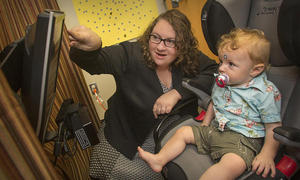'Mama' or 'Dada'? Researcher looks at what words are easiest for kids to learn
A baby’s first words are often Mama or Dada, but new research by a Florida State University psychology professor delves into how children build on these early words to create a colorful vocabulary.

Assistant Professor of Psychology Arielle Borovsky.
“Children leverage their early world knowledge to help them unlock their language skills,” said Assistant Professor Arielle Borovsky, a faculty member in the FSU Department of Psychology. “Knowing a few related words helps children recognize links between new word meanings, and this could be a very useful strategy for helping children learn vocabulary early in life. This might be part of the explanation for why children begin to start ‘talking up a storm’ between the ages of 18 and 24 months.”
So, for example, "Mama" and "Dada" might lead to "sister" or "brother." Or "toy" might lead to "doll" or "ball" or "game."
Borovsky uses the example of a kiwi. Toddlers might know different fruits such as apples or peaches, but not kiwi. However, when confronted with one, it is easier for them to learn the word because they are already familiar with related words.
“Children start to say words somewhere around their first birthday,” Borovsky said. “But they’re not a random subset of adult vocabulary. They’re not learning words like 'stockbroker' or 'bifocals.' That’s common sense, but what’s really new is that they are learning these words in clusters and there might be some words that are easier for children to learn and some that are harder.”
Borovsky’s work was published today in the journal Developmental Science.

Borovsky and her colleagues worked with 32 children who were all 2 years old.
Borovsky and her colleagues worked with 32 children who were all 2 years old. She studied their word development by testing their existing knowledge through a computer program that shows images on a screen of items that are likely familiar to toddlers. Since 2-year-olds are not always communicative, they also employed eye-tracking technology to see which images the children recognized when tested.
On top of the image testing and interviewing parents about their children’s language use, Borovsky and her team also tried to teach the children six new words that had some relation to words they already knew.
They picked complicated words in broad categories familiar to children. The categories were drinks, fruits, body parts, animals, clothing and vehicles. The toddlers heard the words used in five different sentences, while visuals were also shown on the screen.
“Although each child learned the same six words, we used their individual vocabulary survey to identify which three words they already had many neighbors in their vocabulary, and which three had the fewest,” Borovsky said.
They then tested how well the children understood these new words using eye-tracking technology that measures how quickly and reliably the children looked toward pictures of these new objects when they were named.
They found that children recognized the new words more easily when they already knew many other related words.
“This suggests we could use a child’s own vocabulary to find words that would be easier or harder for an individual child to learn at a particular age,” Borovsky said.
Borovsky’s study is part of her ongoing work to understand how children learn and develop vocabularies and also identify early warning signs that a child might have a learning disability. Her lab is also a part of the FSU Center for Developmental Science, a collaboration of child development researchers investigating how children learn, perceive and behave in the world around them.
“To understand what goes wrong, we need to understand how language development works overall,” she said. “If we can identify what’s going wrong at an earlier stage, we can get these kids working with speech therapists or special education experts quicker.”
This work was supported by the National Institutes of Health. Other universities involved in the study were California State University, University of Texas at Dallas and University of California, San Diego.
Watch a video accompanying this article here.

